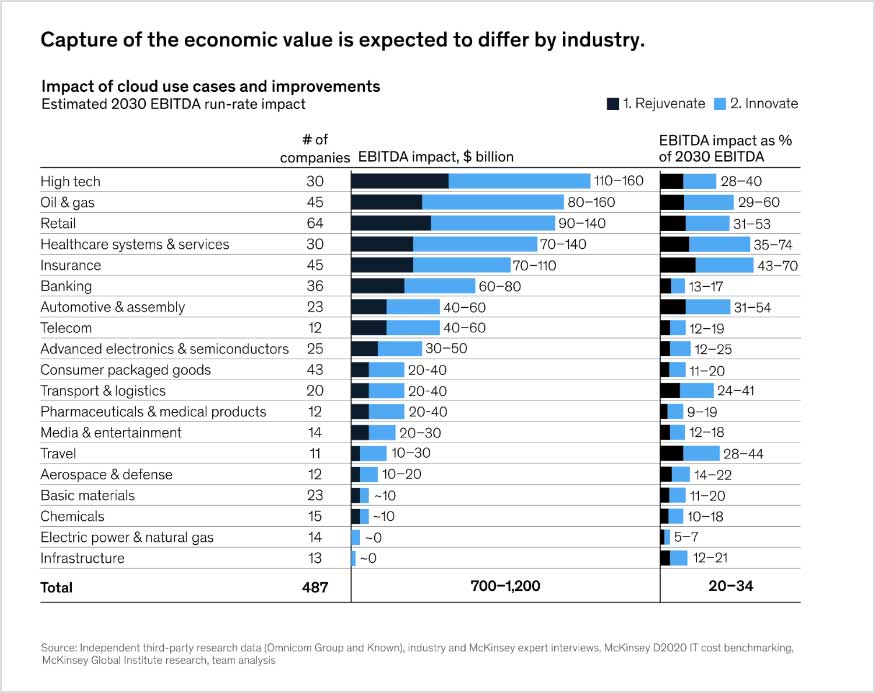The cloud has been widely available as a commercial option for some time now, the globally scaled cloud service operators having established their commercially available services around 15 years ago.
The most common application for PACS and cloud today is PACS hosted in the cloud. This is materially different from a pure play cloud-native PACS. I believe it is critical that any medical organisation today operating in the DICOM environment gain a deep understanding of these two cloud use cases. In particular following my recent experience in Chicago at RSNA, where many traditional PACS vendors present themselves as cloud capable, however they fall into the category of being hosted in the cloud and are not cloud-native.
- PACS hosted in the cloud: The image data is hosted in the cloud but managed by PACS software that wasn’t specifically built for the cloud and cannot utilise the features of the cloud. This is a non-cloud-native PACS.
- Cloud-Native PACS is the next generation use case. This utilises a true cloud-native design for the PACS that is specifically built to take advantage of the benefits that the cloud offers. I have a strongly held view that this is the future of PACS, in fact it exists today in many markets but currently has not been broadly adopted as a production PACS. Importantly, the hurdles to do so have largely been overcome.
Why is this differentiation important?
In the realm of all the services provided by a cloud provider, exists compute (servers) and storage. Above this, are also the cloud-native services that are offered by the cloud provider. These build upon the foundational compute and storage and offer a plethora of general and highly specialised services that applications can utilise.
Although both are offered by the cloud provider, a cloud-hosted PACS or a cloud-based PACS is running the same on-premise application in the zone of services of compute (servers) and storage, which is almost always more expensive that running them on-premise as you’re paying for extremely high availability and durability in excess of what most business require.
Attempting to run a PACS solution that was designed for on-premise deployments in the cloud is cost prohibitive because it cannot utilize cloud-native services and the cost savings and scalability that they provide.
A simple example to demonstrate the sort of cost differences that can be achieved. To store 1GB of data in the a cloud-based PACS (utilising the compute servers and storage services) will be $0.12 USD, to store it in a cloud-native service, S3, it would cost at most, $0.025 USD.
At the outset of the cloud around 2006 and for many years afterwards, the challenges of taking DICOM images to the cloud were:
- Availability of adequate internet bandwidth and its costs
- Cost of cloud data storage was prohibitive given the data size of DICOM image sets
- Cloud hesitancy particularly in healthcare that was driven by concerns regarding security, privacy, durability and sustainability of the cloud providers
What has changed and what has not?
What has changed?
1. Internet speeds and cost dramatically shifted in favour of cloud
Upload and download speeds as noted above have largely been overcome by the rapid growth of bandwidth as well as a substantial real reduction in the costs of the bandwidth. This is a minor cost consideration in 2022 compared to 15 years ago.
In 2008 for example in Australia and New Zealand it was common to see commercially available speeds of 3Mbps. Bring us forward to 2022 and you can commonly access bandwidth in Australia and New Zealand of 10Gbps at costs that are a fraction of what they were in 2008. An x-fold increase in capacity.
2. Cost of cloud computing and Storage
At the early days of adoption of cloud computing the relative cost per GB of cloud storage was high compared to the cost in 2022. For example, when AWS launched their S3 storage, it was priced at 15c per GB per month. Now, at the most expensive storage tier available, the cost is reduced by up to 84% to 2.3c per GB per month. This reduction is even more impressive if you consider that the 2.3c is at today’s value of money. Further info within the link below
https://aws.amazon.com/blogs/aws/aws-storage-update-s3-glacier-price-reductions/

The cloud provider market is highly competitive and combined with other factors such as multiple large-scale providers having established themselves in the market and the continued reduction in cost of computing power this has amongst other factors lead to continuous price erosion of cloud storage and computing fees. Some of the larger companies include AWS (as mentioned above), Google Cloud, Microsoft Azure and Oracle Cloud Platform, all with pricing around the 2.5c USD mark.
https://cast.ai/blog/cloud-pricing-comparison-aws-vs-azure-vs-google-cloud-platform/
Cloud hesitancy is rapidly dissipating; however, it is industry dependent. A number of key industries such as finance and government services have aggressively embraced cloud computing whilst other industries are late adopters.
Ref: https://www.mckinsey.com/business-functions/mckinsey-digital/our-insights/clouds-trillion-dollar-prize-is-up-for-grabs?cid=eml-web (this talks about potential of cloud)
Cloud has immense potential, but most companies are only scratching the surface
Healthcare is among the top 5 industries identified in a study conducted by Omnicom Group and Known for the scale of EBITDA opportunity out to 2030 in the utilisation of cloud computing. They have estimated that the EBITDA upside based on 30 healthcare companies had an estimated 2030 EBITDA run rate impact of $140billion. See table below

What has not changed
I have observed a shift in the approach of incumbent on-premise PACS providers to offering their services hosted in the cloud. The offerings from the traditional PACS providers software are not built as a cloud-native application so therefore inherently face difficulties in effectively shifting into a cloud environment. Therefore, a lift and shift of these platforms for the data storage and computing can prove extremely expensive in comparison with a genuine cloud-native offering. From my observations, the lift and shift of a non-cloud-native PACS provider can incur cloud related costs of storage and compute of five times more than the full featured cloud-native PACS offering.
The value potential of cloud is enormous, but only for companies that understand—and adapt to—the realities of cloud economics.
Genuine SaaS cloud-native PACS platforms give you greater visibility and control/influence on your operating costs. It is more inclusive of your true costs as it includes the provision of very high levels of availability, redundancy and durability.
It is important to consider, both direct and indirect costs of the on-premise model. This includes the capital cost (establishment, increasing server capacity and replacement over time) and ongoing IT support costs while also offering less availability, redundancy and durability.
Cloud storage usually offers duplicate remotely stored versions of the stored data and hence increases security and disaster recovery, and can also act as a second source of data to allow business continuation against hacking, ransom etc
The way existing on-premise PACS software is designed is to be able to operate on persistent, over-provisioned servers. As such the “lift and shift” of this software to the cloud makes it prohibitively expensive to operate the software in the cloud. They are unable to benefit from cloud functions such as auto scaling that automatically adjust the services used based on real time demand. As a result, it also makes it expensive and inefficient to integrate into other system especially as businesses grow by acquisition or merger or if they assume new reporting contracts.
Another aspect that is challenging for vendors who are not operating cloud-native PACS is the cost of block storage (think hard drive on your computer), as opposed to object storage. Cloud-native PACS utilises object storage which has the advantage of being up to ten times cheaper per unit of storage than block storage
This pricing advantage that object storage enjoys is reliant upon the software platform being designed as a cloud-native solution and it would, in my opinion, prove very problematic for an on-premise PACS software platform to be reengineered as a cloud-native PACS
I have heard horror stories of organisations who have attempted to move their current operations into a cloud-based storage model. It has not gone well because they used a “lift and shift” of their servers into virtual servers in the cloud. This goes to the already mentioned limitations of an on-premise PACS hardware which utilises block storage and therefore being incapable of utilising object storage. A further limitation is the inability to automatically manage storage tiering within the cloud. These applications were never intended for cloud use.
As noted above there is a substantial cost difference in block storage as opposed to object storage. This has created the perception that the cloud is an expensive storage option and hence unsuitable for PACS.
What continues to evolve that will continue to pressure organisations to look for ways to make the cloud transition and in my view a cloud-native transition include the following
- The number of images and their resolution per study continuously increasing driven by referrer preferences and imaging technology further stressing fixed capital infrastructure
- Cloud costs continue to erode as utilisation grows improving the metrics
- Major industries such as banking and finance, healthcare and major government departments around the world all of whom have sensitive data utilise the cloud and hence build trust in its security.
- Storage options continue to evolve including options that specifically mention diagnostic imaging as a use case
- Software organisations who are not conflicted by having significant business based on the incumbent model build cloud-native software
- Continuous improvement in bandwidth combined with cost reductions
- Rapid expansion of data centres
- Move away from capital expenditure towards operationalising the costs, aligning the cost structure with demand as well as a need to avoid or minimise recurring capital expenditure. Particularly relevant at this time of the end of ‘free money’
The opportunities to utilise the Next Generation Computing power that the cloud brings are very substantial and can change the financial and operational dynamics of small and large organisations that utilise DICOM studies in their clinical settings. What it also brings which excites me is that the control of your data rests with you. The cloud-native offering from AHS is standards based, APIs, interoperable and vendor neutral. Which allows our clients to readily integrate and/or utilise its data as it requires. We do not use proprietary aspects such as compression algorithms allowing you, the customer to control your own data.
If you are looking at your strategic position in relation to your PACS and contemplating cloud whether as a cloud storage using traditional PACS providers or utilising a cloud-native option, I would love to chat with you.
Check AdvaPACS website to learn more about AdvaPACS cloud-native solution:





